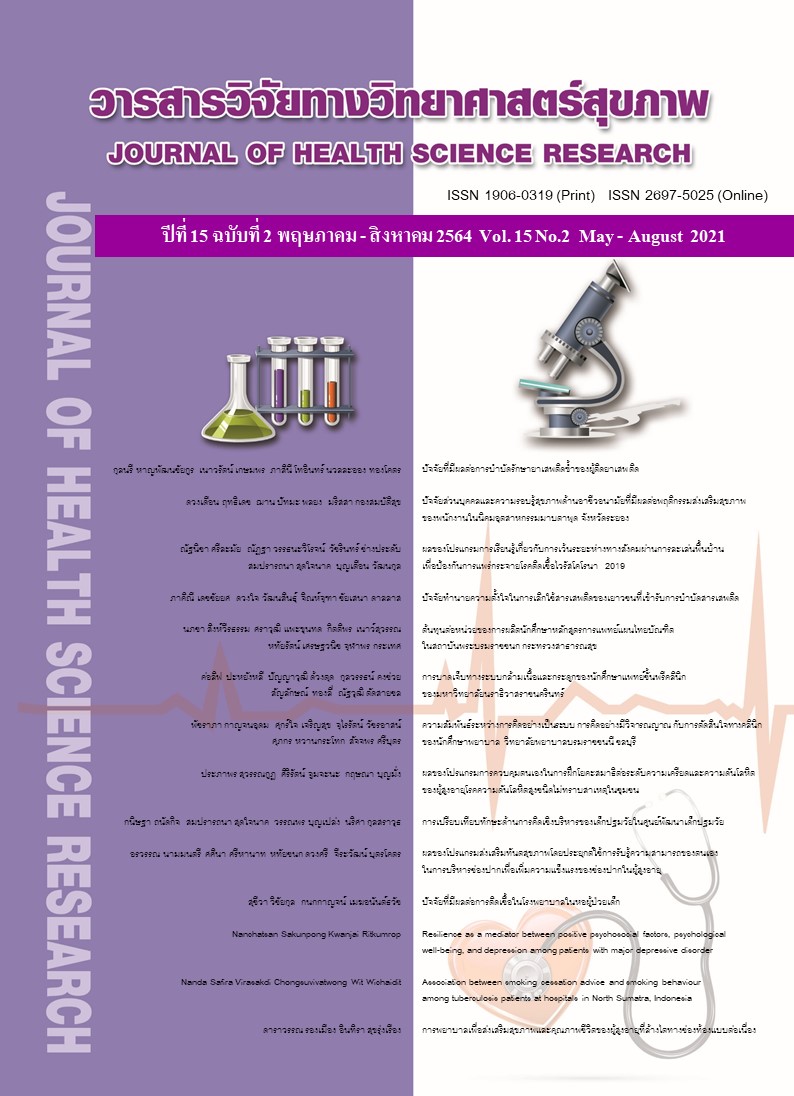ความรอบรู้สุขภาพด้านอาชีวอนามัยและปัจจัยทำนายพฤติกรรมการส่งเสริมสุขภาพของพนักงานในนิคมอุตสาหกรรมมาบตาพุด จังหวัดระยอง
Main Article Content
บทคัดย่อ
ผู้นำสุขภาพของโลกได้สนับสนุนการส่งเสริมสุขภาพด้วยการเพิ่มความรอบรู้ให้กับประชาชน การศึกษาแบบภาคตัดขวางครั้งนี้มีวัตถุประสงค์เพื่อสำรวจความรอบรู้ด้านอาชีวอนามัย และศึกษาปัจจัยทำนายพฤติกรรมส่งเสริมสุขภาพของพนักงานในโรงงานอุตสาหกรรมมาบตาพุด จังหวัดระยอง จำนวน 280 คน ใช้เครื่องมือเป็นแบบสอบถามที่ผ่านการประเมินความตรงมากกว่า 0.5 ทุกข้อ และค่าความเชื่อมั่นของความรอบรู้ด้านอาชีวอนามัยและพฤติกรรมส่งเสริมสุขภาพ เท่ากับ 0.962 และ 0.712 ตามลำดับ ใช้สถิติในการวิเคราะห์ ได้แก่ จำนวน ร้อยละ ค่าเฉลี่ย ส่วนเบี่ยงเบนมาตรฐาน และ Multiple linear regression ด้วยวิธี Enter
ผลการศึกษาพบว่า พนักงานประมาณ 3 ใน 4 เป็นเพศชาย อายุเฉลี่ย 35.4±9.3 ปี ดัชนีมวลกายเท่ากับ 24.4±4.4 กิโลกรัมต่อตารางเมตร ปัจจุบันพนักงานมีพฤติกรรมการสูบบุหรี่ ร้อยละ 19.7 และดื่มเครื่องดื่มแอลกอฮอล์ ร้อยละ 29.0 สำหรับความรอบรู้สุขภาพด้านอาชีวอนามัยพบว่า พนักงานมีคะแนนเฉลี่ยความรอบรู้ ฯ โดยรวม เท่ากับ 153.36±20.58 คะแนน (จากคะแนนเต็ม 215) โดยพนักงานมีความรอบรู้ระดับสูงมากที่สุด ได้แก่ การเข้าถึงข้อมูลด้านสุขภาพ รองลงมาคือการอ่านและทำความเข้าใจ ร้อยละ 60.0 และ 57.1 ตามลำดับ พนักงานมีพฤติกรรมสุขภาพที่ต้องปรับปรุงได้แก่ เมื่ออยู่ในโรงงานควรควบคุมรสชาติอาหารไม่ให้หวาน มัน เค็ม และควรรับประทานผักและผลไม้สด เมื่อวิเคราะห์ปัจจัยทำนายพบว่า ความรอบรู้สุขภาพด้านอาชีวอนามัยและเพศเป็นปัจจัยที่สามารถทำนายพฤติกรรมการส่งเสริมสุขภาพของพนักงานได้อย่างมีนัยสำคัญทางสถิติ (p<0.05) ดังนั้น ในแผนงานความปลอดภัยของโรงงาน เจ้าหน้าที่ความปลอดภัยวิชาชีพควรสอดแทรกเนื้อหาเพิ่มทักษะความรอบรู้สุขภาพ เช่น การเข้าถึงข้อมูลสุขภาพที่น่าเชื่อถือ และควรตรวจสอบหลักโภชนาการในโรงอาหารเพื่อให้เกิดปัจจัยสิ่งแวดล้อมที่เอื้อต่อสุขภาพดีของพนักงาน
Downloads
Article Details
บทความที่ได้รับการตีพิมพ์เป็นลิขสิทธิ์ของวิทยาลัยพยาบาลบรมราชชนนี จังหวัดนนทบุรี
ข้อความที่ปรากฏในบทความแต่ละเรื่องในวารสารวิชาการเล่มนี้เป็นความคิดเห็นส่วนตัวของผู้เขียนแต่ละท่านไม่เกี่ยวข้องกับวิทยาลัยพยาบาลบรมราชชนนี จังหวัดนนทบุรี และคณาจารย์ท่านอื่น ในวิทยาลัยฯ แต่อย่างใด ความรับผิดชอบองค์ประกอบทั้งหมดของบทความแต่ละเรื่องเป็นของผู้เขียนแต่ละท่าน หากมีความผิดพลาดใด ๆ ผู้เขียนแต่ละท่านจะรับผิดชอบบทความของตนเองแต่ผู้เดียว
เอกสารอ้างอิง
Thailand Healthy Strategic Management Office. Wellness center: well adult clinic. Office of Permanent Secretary. Ministry of Public Health; 2019. (in Thai).
Occupational and Environment Disease Division. Situation of surveillance and prevention and disease control among employees in industrial report 2017, [internet]. 2017 [cited 2019 Aug 17]: Available from: http://envocc.ddc.moph. go.th/. (in Thai).
Health Education Division. Promoting and assessing health literacy and health behaviors. Department of Health Service Support. Ministry of Public Health. Nothaburi; 2018. (in Thai).
Bureau of Technical Advisors. Health promotion among workers in workplace. [internet]. 2017 [cited 2019 Aug 3]: Available from: http://advisor.anamai. moph.go.th/main.php?filename =factory1. (in Thai).
Prasittipatt T, Rudtanasudjatum K, Metaphut C, Thetkathuek A. Factors influencing the abdominal obesity of employees in large-sized manufactories in the Eastern region. Journal of Health Science. 2018;27(5):792-9. (in Thai).
Rojanapithayakorn W. Editorial: Introduction to Shanghai declaration. Journal of Health Science. 2017;26(6):971-3. (in Thai).
Darun P, Kairat P.Health literacy factors influencing on health behavior of population in Bueng Kan province. Journal of Department of Health Service Support. 2019;15(3):71-82. (in Thai).
Madican K, Oba N, Supametaporn P. Factors related to health literacy in patients with uncontrolled type 2 diabetes. Journal of Nursing and Health Science. 2020;14(1):38-53. (in Thai).
Tantranont K, Songkham W, Suthakorn W, Srisuphan W, Sakarinkul P, Dhatsuwan J. Development of a scale to measure occupational health and safety literacy scale among industrial workers. Journal of The Royal Thai Army Nurses. 2019; 20(3);247-55. (in Thai).
Ishikawa H, Nomura K, Sato M, Yano E. Developing a measure of communicative and critical health literacy: a pilot study of Japanese office workers. Health Promotion International. 2008;23(3):269-74. doi:10. 1093/heapro/dan017.
Rauscher KJ, Myers DJ. Occupational health literacy and work-related injury among US adolescents. International Journal of Injury Control and Safety promotion. 2014;21(1):81-9. doi: 10.1080/ 17457300.2013.792288.
Yusida H, Suwandi T, Yusuf A, Sholihah Q. Relationship individual factors with occupational health literacy: observational study on industrial workers of Sasirangan in South Kalimantan. International Journal of Scientific and Research Publications. 2016;6(1):481-4.
Azizi N, Karimy M, Abedini R, Armoon B, Motazeri A. Development and validation of the health literacy scale for worker. Int J Occup Environ Med.2019;10(1):30-9. doi:10.15171/ijoem.2019.1498.
. Polyong CP, Rittideah D, Kongsombatsuk M, Praisuthirat K, Samanusron K. Validation of the occupational health literacy test for industrial workforce. Journal of Safety and Health. 2020;13(2):140-57. (in Thai).
Ramakul K, Sripaung N, Laemun N. Health risk related to environmental pollution in Map Ta Phut area, Rayong Province. Journal of Health Science. 2008;17(supplement IV):901-15. (in Thai).
Industrial Estate Authority of Thailand. factory of Map Ta Phut Industrial [Internet]. 2018 [cited 2018 May 17]; Available from: https://www.ieat.go.th/ assets/uploads/ cms/file/201705291220 56321732835.pdf.
Bloom BS, Caploom D. Taxonomy of educational objectives: cognitive domain. New York: David Mckay Company. 1975.
Ministerial regulations on prescribing of criteria and method of conducting health checkup of employees and forwarding the results of health checkup to labour inspector 2004. (in Thai).
Rittideah D, Polyong PC. Effects of the program applying the theory of PRECEDE-PROCEED model to health behavior change among overweight employees in factory, Rayong province. Journal of Nursing Division. 2020;47(3):39-56. (in Thai).
Nutbeam D. The evolving concept of health literacy. Soc Sci Med. 2008;67(12):2072-8.
doi: 10.1016/j.socscimed.2008.09.050.
Hosokawa C, Ishikawa H, Okada M, Kato M, Okuhara T, Kiuchi T. Gender role orientation with health literacy and self-efficacy for healthy eating among Japanese workers in early adulthood. Front Nutr. 2016;3(17):1-9. doi:10.3389/fnut.2016.00017.
Liu YB, Liu L, Li YF, Chen YL. Relationship between health literacy, health-related behaviors and health status: A survey of elderly Chinese. Int J Environ Res Public Health. 2015;12(8):9714-25. doi: 10.3390/ijerph120809714.
Nakamura-Taira N, Izawa S, Yamada KC. Stress underestimation and mental health literacy of depression in Japanese workers: A cross-sectional study. Psychiatry Res. 2018;262:221-8. doi:10.1016/j.psychres.20 17.12.090.
Suka M, Odajima T, Okamoto M, Sumitani M, Igarashi A, Ishikawa H, Kusama M, Yamamoto M, Nakayama T, Sugimori H. Relationship between health literacy, health information access, health behavior, and health status in Japanese people. Patient education and counseling. 2015;98(5):660-8. doi:10.1016/j.pec. 2015.02.013.
Suriart C, Rutchanagul P, Thongbai W.
Health perceptions, health behaviors and health service needs among inmates with metabolic disorders. Ramathibodi Nursing Journal. 2014;20(3):372-87. (in Thai).


